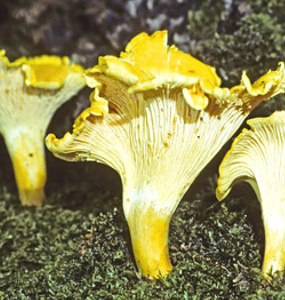Cantharellus cibarius

Image Courtesy of Henry H. Mashburn
| Click to Enlarge |
| Click For Image Gallery |
|
Group of Fungi: Chanterelles Family: Cantharellaceae Latin Name: Cantharellus cibarius Fr. Common Name: Golden Chanterelle Description: Total height 2–5 in (5–12.5 cm); cap 1–4 in (2.5–10 cm) wide, bright yellow to orange at first but becoming paler with age, upper surface smooth, noticeably depressed in the center; margin recurved at first and then becoming wavy; spore-bearing surface pale orange, consisting of a series of thick ribs or folds with blunt edges, these extending down the stalk; the latter 3/4–2 1/2 in (2–6.5 cm) long, 1/4–1 in (0.3–2.5 cm) in diameter, tapering downward, light to dark orange; spores pale yellow in mass. Biological Role: Forms mycorrhizal associations with forest trees. Habitat: On the ground in both broadleaf and conifer forests but especially common under oaks; solitary or occurring in scattered groups. Geographical Distribution: Widely distributed throughout North America. Comments: Cantharellus cibarius is one of the best-known wild edible mushrooms. The fruiting bodies vary considerably in size, color and shape. As such, it can be confused with other species such as Cantharellus appalachiensis, which is smaller and not as brightly colored. Care should be taken not to mistake either of these with Omphalotus illudens, a poisonous agaric that occurs on decaying wood. |
| Go Back |